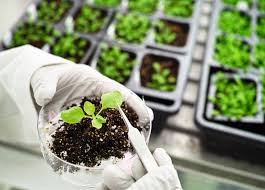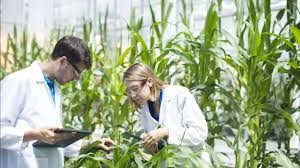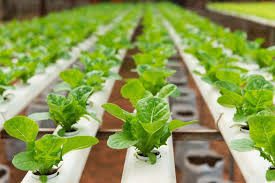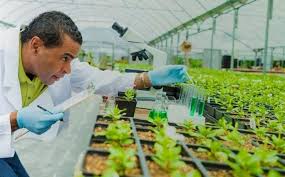Although there is a growing concern about the health impact of agricultural biotechnology, the use of genetic engineering to improve plants or animals will remain a trend in modern farming. Why? The appeal of this method is in its capacity to increase production and improve global food security. Moreover, genetically modified organisms have been proven safe for human health.
The major challenge that could render GMOs unsafe for consumption is farmers’ failure to comply with regulatory standards when practicing agricultural biotechnology. Otherwise, agricultural biotechnology can improve the quality of farm produce and help create more climate-resilient crops.
Key Techniques in Agricultural Biotechnology
1. Genetic Engineering: This technique involves directly manipulating an organism’s DNA to introduce desirable traits. Scientists can add, remove, or alter specific genes to enhance crop characteristics such as pest resistance, drought tolerance, or improved nutritional content. Genetic engineering has led to the development of genetically modified organisms (GMOs), which can exhibit traits not naturally found in the species.
2. Marker-Assisted Selection (MAS): MAS is a breeding technique that uses molecular markers to select plants or animals that possess desired traits. By identifying specific DNA sequences associated with traits such as disease resistance or yield potential, breeders can accelerate the selection process, making it more efficient than traditional breeding methods.
3. Tissue Culture: This technique involves growing plant cells, tissues, or organs in a controlled environment on a nutrient medium. Tissue culture allows for the rapid propagation of disease-free plants and is used for cloning, conservation of rare species, and producing hybrids. It also aids in producing uniform crops, as all plants derived from tissue culture are genetically identical.
4. CRISPR-Cas9 Technology: CRISPR-Cas9 is a revolutionary gene-editing tool that allows for precise modifications to an organism’s genome. By utilizing this technique, scientists can make targeted changes to specific genes, which can improve crop traits such as resistance to pests and diseases or enhance nutritional value. This technology offers a faster and more accurate alternative to traditional genetic engineering methods.
5. RNA Interference (RNAi): RNAi is a natural process that regulates gene expression. In agricultural biotechnology, it is used to silence specific genes responsible for undesirable traits, such as susceptibility to pests or disease. By inhibiting these genes, crops can be developed to be more resilient without introducing foreign DNA.
Benefits of Agricultural Biotechnology
1. Increased Crop Yields: Biotechnology enables the development of crops with enhanced traits, leading to increased productivity. Crops engineered for resistance to pests, diseases, and environmental stresses can yield more under challenging conditions, thereby contributing to food security.
2. Reduced Agricultural Inputs: Biotech crops often require fewer chemical inputs, such as pesticides and fertilizers. For example, crops engineered for pest resistance can significantly reduce the need for chemical insecticides, which lowers production costs and minimizes environmental impact.
3. Enhanced Nutritional Content: Biotechnology can improve the nutritional quality of crops. For instance, genetically modified rice, known as Golden Rice, is fortified with vitamin A to combat deficiencies in populations that rely heavily on rice as a staple food. This biofortification can help address global health issues related to malnutrition.
4. Environmental Sustainability: Biotech crops can contribute to sustainable agricultural practices. By reducing the need for chemical inputs, minimizing soil erosion through no-till farming, and improving water-use efficiency, agricultural biotechnology supports environmentally friendly farming practices.
5. Adaptation to Climate Change: Biotechnology can help develop crops that are resilient to climate change by enhancing tolerance to drought, heat, and salinity. These improvements enable farmers to maintain productivity even as environmental conditions become more challenging.
Challenges and Controversies in Agricultural Biotechnology

1. Safety Concerns: There are ongoing debates about the safety of genetically modified organisms (GMOs) for human consumption and environmental impact. Critics raise concerns about potential allergenicity, unintended effects on non-target species, and the long-term consequences of GMO use on ecosystems.
2. Economic Concerns: The use of biotechnology can lead to market monopolies, as a few companies hold patents for many biotech traits. This concentration can limit farmers’ choices, increase seed costs, and affect agricultural diversity, raising ethical and economic concerns among farmers and consumers.
3. Ethical Issues: The manipulation of genetic material raises ethical questions about “playing God” and the potential consequences of altering natural organisms. Public perception can be influenced by cultural beliefs, leading to resistance against adopting biotechnological innovations.
4. Regulatory Hurdles: Navigating the regulatory landscape can be complex and time-consuming for biotechnology companies. Variability in regulations across countries can affect the approval process for GMOs, limiting their availability in certain markets and hindering international trade.
5. Public Perception: Misinformation and lack of understanding about agricultural biotechnology contribute to public skepticism and resistance. Effective communication and transparency regarding the benefits and risks of biotechnology are essential for gaining public trust.
Regulatory Framework for Agricultural Biotechnology
1. Pre-Market Assessment: Before a biotech product can be approved for commercial use, it undergoes rigorous safety assessments. Regulatory agencies evaluate potential health and environmental impacts, ensuring that products meet safety standards. In the U.S., agencies like the Environmental Protection Agency (EPA), the Food and Drug Administration (FDA), and the U.S. Department of Agriculture (USDA) play critical roles in this assessment.
2. International Guidelines: Various international organizations, such as the World Health Organization (WHO) and the Food and Agriculture Organization (FAO), provide guidelines for the safe use of biotechnology in agriculture. These guidelines aim to harmonize regulations and ensure that global standards are upheld.
3. Labeling Requirements: In some countries, regulations mandate labeling of GMO products, allowing consumers to make informed choices. Labeling practices vary globally, with some regions advocating for transparency, while others have more lenient requirements.
4. Biosafety Protocols: Regulatory frameworks also establish biosafety protocols to manage potential risks associated with the release of GMOs into the environment. These protocols guide the evaluation of potential impacts on biodiversity and non-target organisms.
5. Post-Market Monitoring: Some regulatory bodies require post-market monitoring of biotech products to ensure their continued safety and effectiveness. This monitoring can include assessing environmental impacts, food safety, and any unintended consequences that may arise after commercialization.
Read Also: Chinchilla Endangered Rodent
Applications of Biotechnology in Crop Improvement

1. Genetic Modification: Genetic modification (GM) involves altering the genetic material of crops to express desired traits. This includes developing varieties resistant to pests, diseases, and herbicides. Examples include Bt cotton and Bt corn, which produce a natural insecticide to protect against pests.
2. Marker-Assisted Selection (MAS): MAS is used to enhance traditional breeding techniques. It involves identifying specific DNA markers linked to desirable traits, enabling breeders to select plants more efficiently. This method speeds up the development of new crop varieties with improved characteristics.
3. Tissue Culture: Tissue culture allows for the mass propagation of plants under sterile conditions. This technique is essential for producing disease-free planting material and generating hybrids. It is particularly useful for crops that are difficult to propagate through conventional methods.
4. CRISPR-Cas9 Gene Editing: CRISPR-Cas9 is a powerful tool that allows for precise editing of plant genomes. It can be used to enhance specific traits such as yield, stress tolerance, and nutritional content. This technology provides a faster and more accurate alternative to traditional genetic engineering.
5. Synthetic Biology: Synthetic biology combines biology and engineering to design and construct new biological parts. It can create crops with novel traits, such as improved nutrient uptake or enhanced photosynthesis, leading to higher yields and better resource efficiency.
Role of Biotechnology in Pest and Disease Management
1. Development of Pest-Resistant Varieties: Biotechnology enables the creation of crops with built-in resistance to pests. By introducing genes that confer resistance, crops can be protected without the need for chemical pesticides, reducing environmental impact and improving sustainability.
2. Biopesticides: Biotechnology facilitates the production of biopesticides, which are derived from natural materials. These products can be more environmentally friendly and target specific pests, minimizing harm to non-target organisms and reducing chemical residues in the environment.
3. Disease Resistance: Through genetic engineering, crops can be developed to resist various diseases. By identifying and incorporating genes that provide disease resistance, biotech crops can help reduce crop losses and improve food security.
4. Integrated Pest Management (IPM): Biotechnology supports IPM strategies by providing tools to monitor pest populations and predict outbreaks. This approach combines biotechnology with cultural, biological, and chemical control methods, leading to more sustainable pest management.
5. Pathogen Detection: Biotechnology techniques, such as molecular diagnostics, allow for rapid detection of plant pathogens. Early identification helps manage disease outbreaks more effectively, reducing crop loss and improving overall plant health.
Read Also: Powdery Scab (Potatoes): Description, Damages Caused, Control and Preventive Measures
Biotechnology and Sustainable Agriculture

1. Resource Efficiency: Biotech crops can improve resource use efficiency, requiring less water and fertilizers. For example, crops engineered for drought tolerance can thrive in arid conditions, promoting sustainable farming practices in water-scarce regions.
2. Soil Health Improvement: Some biotechnological approaches enhance soil health by promoting beneficial microorganisms that improve nutrient availability and soil structure. This can lead to healthier crops and reduced dependence on chemical fertilizers.
3. Conservation of Biodiversity: Biotechnology can help preserve plant biodiversity by enabling the conservation of endangered species through techniques like tissue culture and genetic banking. This contributes to the sustainability of ecosystems and agricultural systems.
4. Reduced Chemical Use: By developing pest-resistant and disease-resistant crops, biotechnology reduces the need for chemical pesticides and herbicides. This leads to lower environmental pollution and healthier ecosystems.
5. Climate Change Adaptation: Biotechnology can contribute to developing crops that are resilient to climate change effects, such as increased temperatures and changing rainfall patterns. These adaptations help ensure food security in the face of a changing climate.
Economic Impact of Agricultural Biotechnology
1. Increased Productivity: The adoption of biotech crops has led to significant increases in crop yields. Higher productivity translates into greater food supply, benefiting farmers, consumers, and economies as a whole.
2. Cost Savings for Farmers: Biotech crops often require fewer inputs, such as pesticides and fertilizers, reducing production costs for farmers. This leads to higher profit margins and increased economic viability for farmers, particularly in developing countries.
3. Global Trade Opportunities: Agricultural biotechnology can open new markets for biotech crops and products. Countries that adopt biotechnology can export their products to regions with demand for high-yielding, pest-resistant crops, enhancing global trade.
4. Job Creation: The biotechnology sector generates employment opportunities in research, development, manufacturing, and distribution. As the industry grows, it creates jobs across various sectors, contributing to economic development.
5. Rural Development: Increased agricultural productivity and profitability can stimulate rural economies. As farmers thrive, they can invest in local communities, leading to improved infrastructure, education, and services in rural areas.
Do you have any questions, suggestions, or contributions? If so, please feel free to use the comment box below to share your thoughts. We also encourage you to kindly share this information with others who might benefit from it. Since we can’t reach everyone at once, we truly appreciate your help in spreading the word. Thank you so much for your support and for sharing!
Read Also: How to Start an Urban Farm






